This vehicle is an old movie car. Having been driven by Bob Hope, Jimmy Stewart, George Jessel, Vera Miles, Darren McGavin and a host of other movie stars, it was owned by Warner Brothers studios. Movies included were “The Spirit of St Louis”, and “The Story of Mayor Jimmy Walker” in the late 50’s.
The car was sold in 1954 from a widow in Connecticut to the Murchio Museum in Greenwood Lake, New York. There it sat for many years being admired. In 1974 the Murchio Museum was altering inventory and Mrs. Murchio decided to sell the car to a friend of my father. The car left NY and headed to Owl’s Head, Maine. Not the Owl’s Head museum but a private garage where it sat for only a few days. Visiting his friend, my father left from his weekend in Maine with the Chrysler. The odometer read 18,000 miles which I am quite sure is real miles! Because this car was used primarily in movies, every time the doors closed, paint fell off. That was because it was never prepped right for a paint job. It was sprayed for color only.
In 1979 the car finally made it’s way to Vermont where it’s been enjoyed since then. I have put hundreds of miles on it over the years. Five years ago or so, I had the car painted because there wasn’t much paint left on it. There was no real need for restoration because is was sitting in the museum all those years. No rust at all. It may have never been rained on. The body shop that painted it was shocked at the condition and the method of manufacturing. Wood framing in the doors and the shear amount of hand work is impressive. The convertible top and all side curtains are original and in prefect condition. The passenger side has a little golf bag door where you slide your bag into the rumble seat compartment. The windshield lays flat giving a real sporty look. Wood spoke wheels add a very classy look. The chrome work is still very nice. I find that polishing old chrome once a year or so keeps it from rusting away.
The suspension is rather unique. The driver seat is independently sprung for a cushioned ride and the suspension is something to be enjoyed. I have a 1928 Model A as well. Comparing the rides is like comparing a Cadillac to a VW! The instrument panel even has Walter Chrysler stamped on it. All instruments are in working order. The only change I made was to add an electric fuel pump for ease.
The engine remains untouched. It’s called a “red head” engine. The head should be painted red, this one is not by accident. The “red heads” were very desirable. They offered higher compression taking the Chrysler from 60 hp to 75 hp. A nice increase. It also has dual points! A bit unusual for that era. Cruising at 55 today is no problem.
The original price in 1928 was $2700.00. My father bought it for $3000.00 in 1974. Not a bad deal back then. With another season here, perhaps you’ll see it around Lake Champlain.










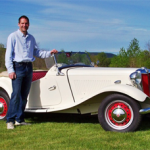 Please email all inquiries to:
Please email all inquiries to: 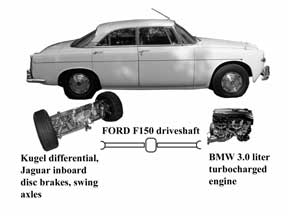
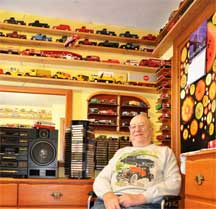 If you remember, Wheel Tracks had a really nice story about a fire truck from St. Albans, VT that was turned into a ‘Speedster’ back in the February issue. A question was simply asked at the end about the car in the picture that was “the fire chief’s car. “What make and year is the car?”
If you remember, Wheel Tracks had a really nice story about a fire truck from St. Albans, VT that was turned into a ‘Speedster’ back in the February issue. A question was simply asked at the end about the car in the picture that was “the fire chief’s car. “What make and year is the car?”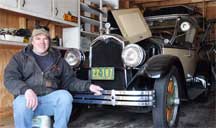 The Buick is owned today by Sue and Greg Sabens and the “garage” was just up the road from Alden’s home. Greg’s Dad, Dell, had purchased it from Charlie Arnholm on August 12th 1965, Charlie was a longtime VAE member and club president in 1961. A meeting was set up and Jim Sears and I went South to find this garage. You can see the garage on the front page with the Buick looking out from the shadows. As it turned out, the gar-age is at the home of Dell’s wife, Helen, who was the person who did all the leather and fabric work for the Buick restoration. The family lost Dell some fifteen years ago, but it was easy for us to know a little about him from seeing his part of the loving restoration on this car. Charlie Arnholm was known for his great abilities with the pin-striping brush and the Buick carries some of his work. Charlie Arnholm was also the second
The Buick is owned today by Sue and Greg Sabens and the “garage” was just up the road from Alden’s home. Greg’s Dad, Dell, had purchased it from Charlie Arnholm on August 12th 1965, Charlie was a longtime VAE member and club president in 1961. A meeting was set up and Jim Sears and I went South to find this garage. You can see the garage on the front page with the Buick looking out from the shadows. As it turned out, the gar-age is at the home of Dell’s wife, Helen, who was the person who did all the leather and fabric work for the Buick restoration. The family lost Dell some fifteen years ago, but it was easy for us to know a little about him from seeing his part of the loving restoration on this car. Charlie Arnholm was known for his great abilities with the pin-striping brush and the Buick carries some of his work. Charlie Arnholm was also the second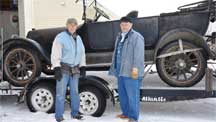 January 20th, 2013 was a cold and windy day in Greensboro Bend. Hundreds of Snow Rollers were poked up in the white fields around Dave and Dot Maunsell’s home on Cook Hill. Dot had prepared a great lunch while outside at times one could see only a few feet through the swilling snow, only the Champlain Valley folks seems to be amazed at the weather outside.
January 20th, 2013 was a cold and windy day in Greensboro Bend. Hundreds of Snow Rollers were poked up in the white fields around Dave and Dot Maunsell’s home on Cook Hill. Dot had prepared a great lunch while outside at times one could see only a few feet through the swilling snow, only the Champlain Valley folks seems to be amazed at the weather outside.